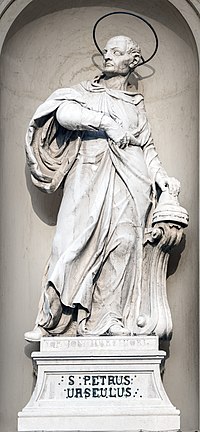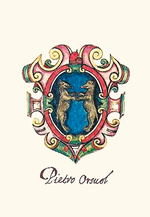Pietro I Orseolo
St. Pietro Orseolo,OSBCam | |
|---|---|
 | |
| Doge | |
| Born | 928 Udine,Republic of Venice |
| Died | 10 January 987 Cuxa,County of Conflent |
| Venerated in | Catholic Church |
| Beatified | 1027 byArnulf |
| Canonized | 1731,Rome,Papal States,byPope Clement XII |
| Majorshrine | Prades, Pyrénées-Orientales,France |
| Feast | 10 January; 19 January (Camaldolese Hermits) |
Pietro I OrseoloOSBCam,also namedPeter Urseulus,(928–987) was theDoge of Venicefrom 976 until 978. He abdicated his office and left in the middle of the night to become amonk.He later entered the order of the Camaldolese Hermits of Mount Corona. He is venerated as asaintin theCatholic Church.In 1733 the Venetian librarian Giuseppe Bettinelli published an edition of a biography written by the FriarFulgenzio Manfrediin 1606.[1]
Early life[edit]
Orseolo was born in 928 nearUdineto one of the more powerful families inVenice:theOrseolowere the descendants of DogeTeodato Ipatoand DogeOrso Ipato.At the age of 20 he was named commander of the Venetian fleet, performing distinguished service as a soldier; he waged successful campaigns against theDalmatianpirates.He was also devoted to theCatholic Church.He had one son namedPietro II Orseolo,who also became a Doge, and a daughter who married to Giovanni Morosini, a member of theHouse of Morosini.[2]
Reign[edit]

In 976, the sitting doge,Pietro IV Candiano,was killed in a revolution that protested his attempts to create a monarchy. According to a statement by the Camaldolese monk andcardinal,Peter Damian,Orseolo himself had led a conspiracy against Candiano. This statement, however, cannot be verified. Nonetheless, Orseolo was elected as his successor. His wife and consort wasFelicia Malipiero.[3]
As doge, Orseolo demonstrated a good deal of talent in restoring order to an unsettled Venice and showed remarkable generosity in the treatment of his predecessor's widow. He built hospitals and cared for widows, orphans and pilgrims. Out of his own resources he began the reconstruction of the ducal chapel, nowSt. Mark's Basilica,and theDoge's Palace,which had been destroyed during the revolution, along with a great part of the city. Two years later, on 1 September 978, seemingly without notifying anyone, not even his wife and children, he left Venice with Abbot Guarin and three other Venetians (one of whom was St.Romuald) to join theBenedictine(nowCistercian) abbey atSaint-Michel-de-Cuxa(Catalan:Sant Miquel de Cuixà) inPrades(Catalan:Prada), southernFrance.
Here Orseolo led a life of greatasceticism,performing the most menial tasks. There is some evidence that he had been considering such an action for some time. His only contact with Venice was to instruct his grandsonOtto[4](who would become doge in 1008) in the life of Christian virtue. After some years as a monk at the abbey, probably with the encouragement of Saint Romuald (who later went on to found theCamaldolesebranch of the Benedictines), Orseolo left the monastery to become ahermitin the surrounding forest, a calling he followed for seven years until he died. His body is buried in the village church inPrades(Catalan:Prada), France.
Veneration[edit]
Forty years after his death, in 1027, Orseolo was officially recognized as ablessedby the local bishop.
Orseolo is venerated as asaintby theCatholic Church,his cultus having been confirmed by hisequivalent canonizationin 1731 byPope Clement XII,who set hisfeast dayfor 14 January. Thereform of the liturgical calendarin 1969 transferred the feast to 10 January, the day of his death. The Camaldolese order celebrates his memory on 19 January.[5]
See also[edit]
References[edit]
- ^Guido Grandi (1733).Vita del glorioso prencipe S. Pietro Orseolo doge di Venezia, indi monaco, ed eremita santissimo, primo discepolo di S. Romualdo fondatore dell'Ordine camaldolese; scritta da un religioso di detto Ordine.(in Italian). unknown library. per Giuseppe Bettinelli in Merceria.
- ^Marco Pozza (2015)."PIETRO Orseolo, santo".treccani.it/enciclopedia.Dizionario Biografico degli Italiani, volume 83.Retrieved2022-11-02.
- ^Staley, Edgcumbe (1910).The dogaressas of Venice: The wives of the doges.University of California Libraries. London: T. W. Laurie.
- ^Turton, W.H. (1928).The Plantagenet Ancestry.London: Phillimore.
- ^"San Pietro Orseolo (Urseolo)".Santi e Beati(in Italian).
External links[edit]
- Peter Urseolusat theCatholic Encyclopedia
- Attwater, Donald and Catherine Rachel John.The Penguin Dictionary of Saints.3rd edition. New York: Penguin Books, 1993.ISBN0-14-051312-4.
